Overview
In the journey of building a startup, many founders grapple with the challenge of establishing a distinct brand identity. This struggle can often lead to feelings of uncertainty and isolation, as the connection with target audiences remains elusive. The implications of not defining a clear tone of voice can be profound; without it, brands risk being overlooked in a crowded marketplace, which can dampen trust and hinder customer loyalty.
However, there is hope. By defining a tone of voice, startups can create a meaningful connection with their audience. A well-crafted tone not only enhances brand recognition but also fosters trust and loyalty, ultimately driving revenue growth. Numerous statistics and successful brand stories illustrate this powerful impact, showing that when brands communicate authentically, they resonate more deeply with their customers.
Imagine a startup that shares its story openly, inviting customers to be part of its journey. This approach not only humanizes the brand but also nurtures a sense of community and belonging. By sharing personal anecdotes and testimonials, founders can evoke empathy and relate to their audience's experiences, making them feel seen and understood.
At RNO1, we understand these challenges and stand ready to support you. Our expertise lies in helping startups define their tone of voice, ensuring that your brand not only stands out but also connects with your audience on a deeper level. Together, we can craft a narrative that reflects your values and speaks directly to the hearts of your customers.
Introduction
Establishing a distinct tone of voice is a critical yet often overlooked component of brand identity for startups. As new ventures strive to carve out their niche in a competitive landscape, the ability to communicate effectively and authentically can make all the difference in attracting and retaining customers.
Yet, many founders grapple with defining this essential aspect of their brand, leading to confusion and missed opportunities. This struggle can feel isolating, as the pressure to connect with audiences grows.
How can startups navigate the complexities of tone of voice to foster genuine connections and build lasting loyalty with their audience? The journey toward clarity in communication is not just a professional necessity; it’s a heartfelt endeavor that can transform relationships with customers.
By embracing this challenge, startups can cultivate a voice that resonates deeply, inviting customers to engage and share in their vision.
RNO1: Crafting a Distinct Tone of Voice for Brand Identity
Establishing a unique tone of voice definition is essential for nurturing a strong company identity, especially for new ventures. Many founders struggle to create a distinctive identity that effectively conveys their values and character, which can make it challenging to stand apart from competitors. This differentiation is essential not only for connecting with target audiences but also for fostering lasting loyalty.
At RNO1, we understand these challenges and employ creative strategies, such as the Ryde initiative, to ensure that communication aligns seamlessly with our mission and vision. This approach cultivates a cohesive identity that not only attracts but also retains customers.
By focusing on design, we enhance the overall experience of our label, maximizing marketability through Return On Design & Digital (RODD) strategies. Expert insights reveal that the tone of voice definition, when clearly defined, can significantly improve identity recognition and trust, making it an indispensable component of effective marketing strategies for new ventures.
We are here to support you in this journey, helping you to build a brand that resonates deeply with your audience.
Defining Tone of Voice: The Foundation of Brand Communication
The tone of voice definition is essential for how an organization connects with its audience, as it encompasses word selection, style, and emotional influence. For many startups, the challenge lies in establishing a clear communication style. This is essential, as it shapes every interaction, from marketing content to customer service. A steady voice not only nurtures familiarity but also builds trust, making it easier for audiences to connect with the company.
Research shows that a unique sound can significantly enhance brand recognition and loyalty; for instance:
- 82% of emotionally connected customers demonstrate brand loyalty in their purchasing decisions.
- 81% of consumers consider trust a key factor in their buying choices, according to the 2024 Edelman Trust Barometer.
Successful companies like Slack illustrate this balance, merging a friendly approach with efficiency, which has led to a remarkable 28% annual user growth and a 95% customer satisfaction rate. Moreover, a clearly articulated communication style can lead to a 68% increase in revenue, as consistent branding across platforms resonates with consumers.
In a competitive landscape, startups must consider the tone of voice definition as a strategic asset that not only reflects their values but also fosters meaningful connections with their audience. Recording a voice guide and tailoring style for various platforms are vital steps in maintaining consistency and relevance in communication. By embracing these practices, startups can create a supportive environment that resonates deeply with their audience, encouraging lasting relationships.
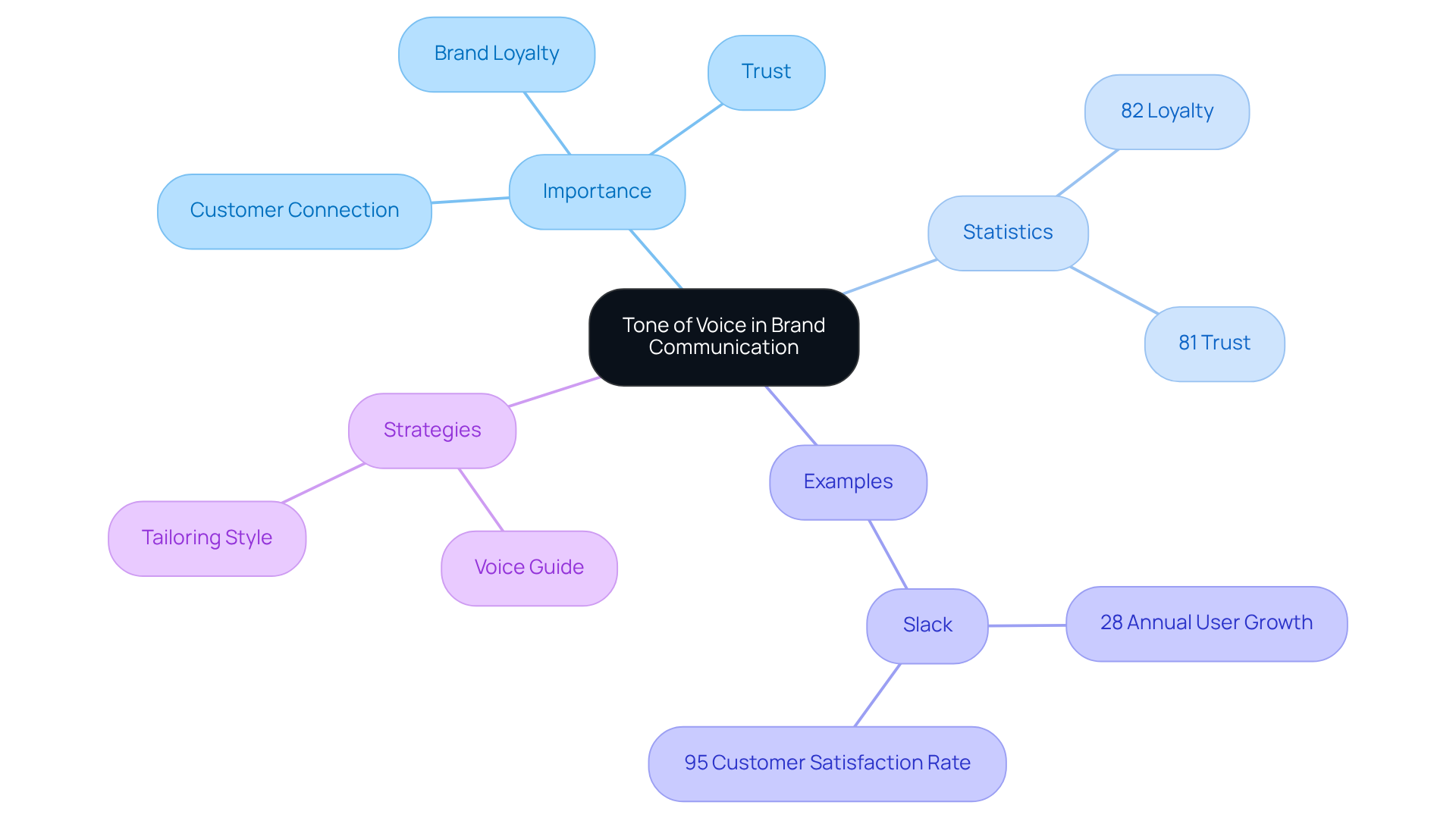
Building Trust: The Role of Tone of Voice in Brand Perception
The tone of voice definition in a company's communication is crucial for shaping consumer perception and building trust, particularly as RNO1 embarks on the strategic rebranding of Founder's Haven, which aims to empower modern founders for digital success. Many startups face the challenge of connecting authentically with their audience, which is essential for achieving long-term success.
Research indicates that:
- 63% of consumers feel confident in financial companies that communicate in strong, authoritative tones.
- 82% of patients prefer organizations that demonstrate empathy and clarity.
- 57% of users view companies more favorably when they adopt straightforward, conversational styles in technical documentation.
By intentionally crafting their tone of voice definition, new companies can express trustworthiness and openness, which nurtures customer engagement and loyalty. As Anant Goel wisely states, 'Your manner of speaking and sound are the heartbeats of your company's identity.' This highlights the importance for startups to prioritize authenticity in their communication, as understanding the tone of voice definition not only enhances how their reputation is perceived but also fosters enduring relationships with customers.
Furthermore, maintaining a consistent brand style can boost consumer trust by 33%, demonstrating the tangible benefits of a well-defined tone of voice definition in communication. RNO1's expertise in performance marketing within the rapidly evolving eCommerce landscape, illustrated in their case study with Cirkul, demonstrates how a compelling communication style can drive success in competitive markets, particularly by aligning messaging with consumer expectations and cultivating deeper connections.
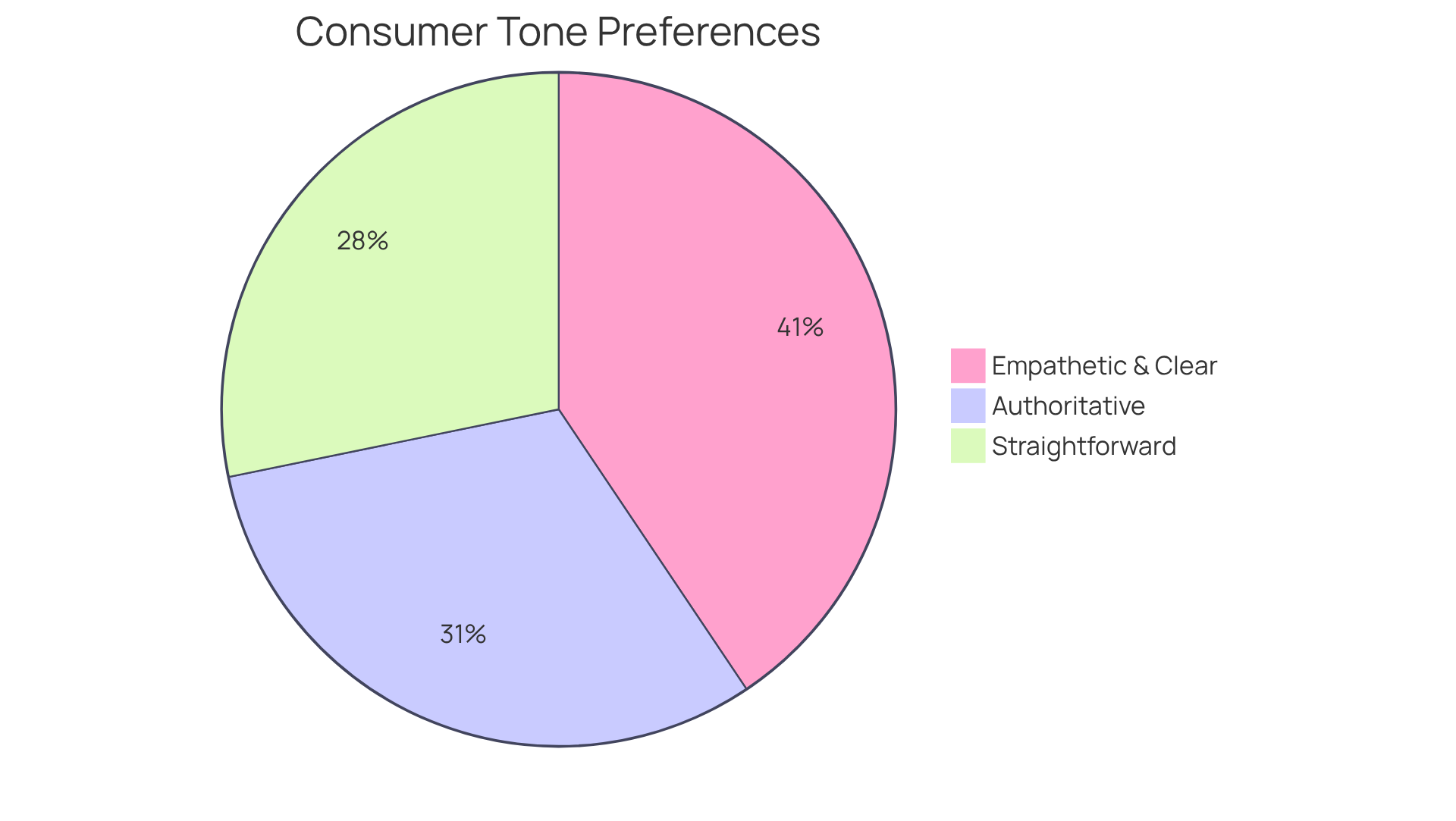
Identifying Your Tone of Voice: Aligning with Audience Expectations
To effectively establish a suitable manner of speaking, startups often face the challenge of truly understanding their target audience, which relates to the tone of voice definition. This involves a deep dive into demographics, preferences, and communication styles. When companies align their style with audience expectations, they can create content that feels both captivating and relevant. For instance, a younger demographic might respond more positively to a casual and playful tone, while a professional audience may lean towards a more formal approach. This strategic alignment not only enhances messaging effectiveness but is particularly vital for contemporary founders who aspire to optimize their digital presence.
Many startups have discovered that by adjusting their communication style to resonate with their audience, they experience a significant boost in engagement rates. Take RNO1's strategic rebranding of Founder's Haven as an example; it illustrates how companies targeting Gen Z often embrace a more casual and relatable style, which aligns beautifully with this demographic's desire for authenticity and connection. Conversely, those targeting corporate clients typically adopt a more refined and authoritative tone, reflecting the expectations of a professional environment.
Expert insights emphasize the importance of audience analysis in this journey. Understanding the nuances of your audience’s preferences allows for a more tailored approach, ensuring that the company’s identity aligns with the tone of voice definition while also meeting the expectations of its target market. This alignment is essential for building trust and nurturing lasting relationships with customers. In the context of RNO1's performance marketing expertise in hyper-scaling eCommerce, this thoughtful approach significantly enhances the effectiveness of brand messaging, fostering a sense of community and support that resonates with startup founders.
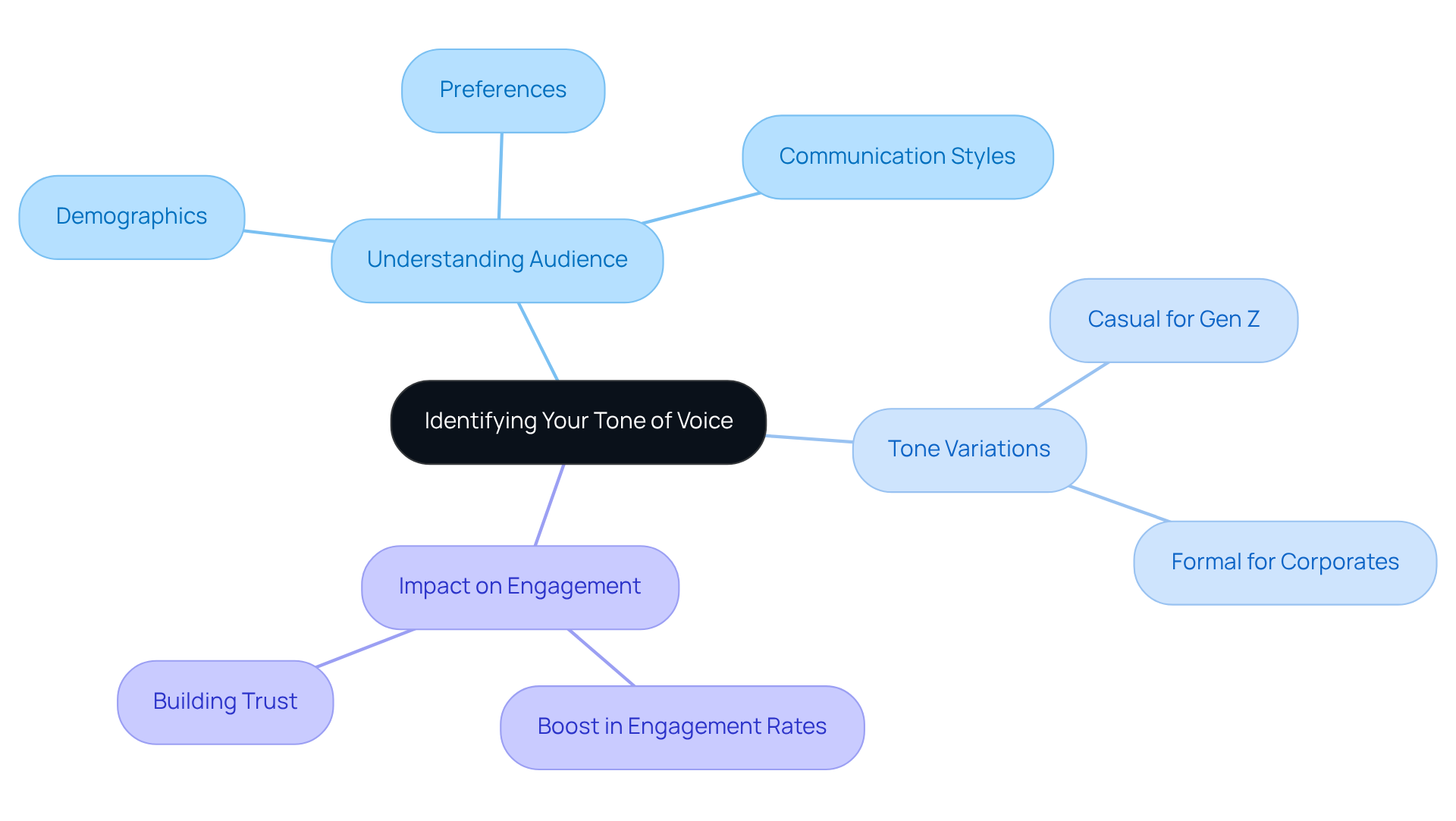
Leveraging Emotional Impact: Choosing the Right Tone for Your Message
The tone of voice definition is vital in stirring emotions and influencing how our messages are received. Many startups face the challenge of selecting a style that aligns with the tone of voice definition, resonating emotionally with their audience. For instance, the tone of voice definition indicates that a nurturing tone is particularly effective for businesses tackling sensitive issues, while an enthusiastic approach can generate excitement for new product launches.
Research shows that:
- 70% of potential customers are moved emotionally by advertisements, highlighting the importance of emotional engagement.
- 90% of prospective clients expect consistent experiences across all marketing platforms, underscoring the need for a cohesive style across various channels.
By thoughtfully harnessing emotional impact and applying the tone of voice definition, companies can build stronger connections with their audience, fostering greater customer loyalty and engagement. It's noteworthy that:
- 71% of consumers are likely to recommend a company based on an emotional connection, presenting a valuable opportunity for new ventures to cultivate advocates through mindful expression.
- Emotional marketing can also contribute to a remarkable 40% increase in new account growth, demonstrating the real benefits of connecting with customers on an emotional level.
To refine their communication style, startups should actively seek audience feedback through surveys and social media, ensuring that their chosen manner resonates with their target demographic. As Richard Branson wisely states, authenticity in branding is essential; aligning one's voice with brand values nurtures trust and connection with consumers.
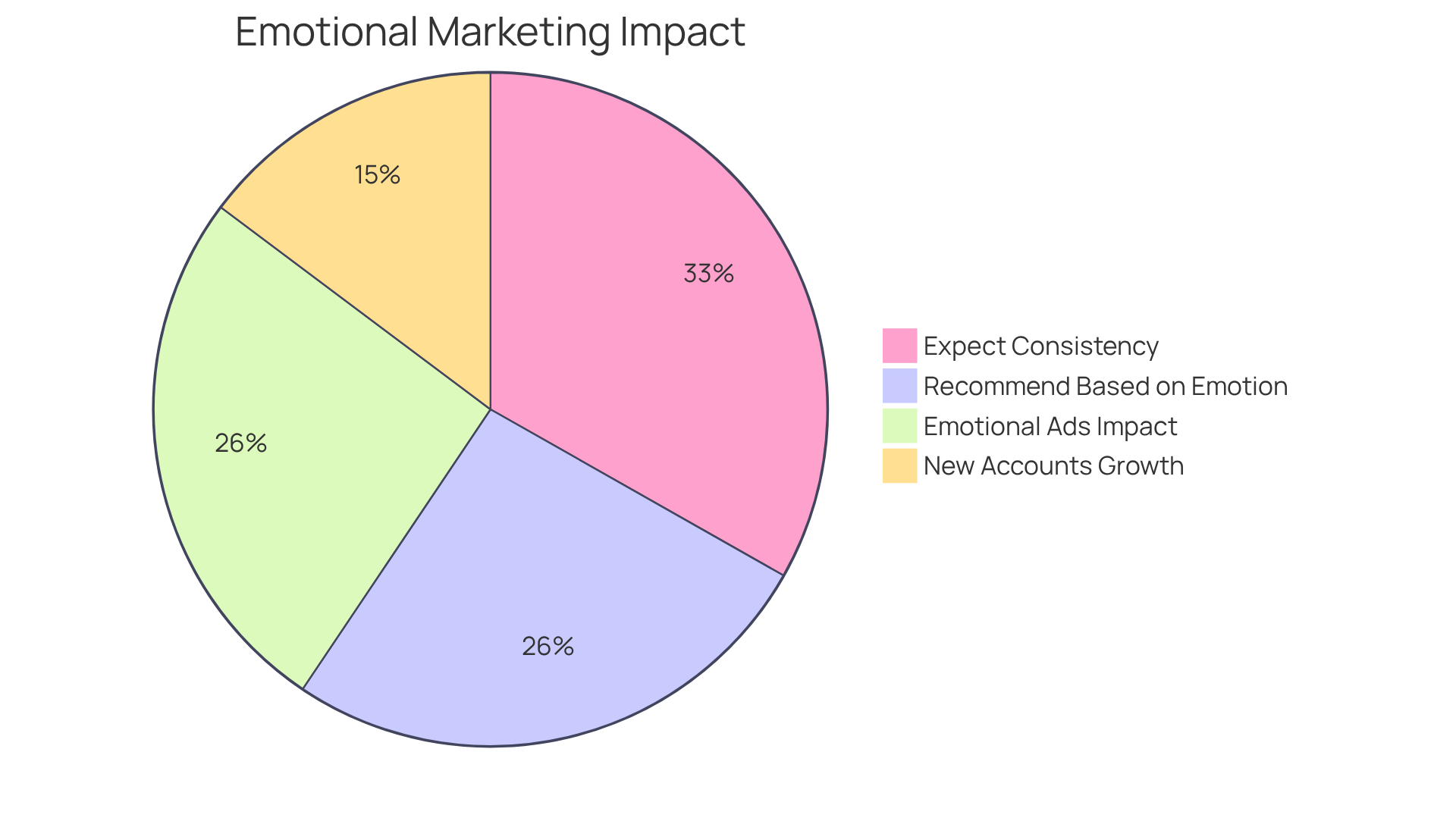
Exploring Tone Dimensions: Formality, Humor, and Engagement
The tone of voice definition is a multifaceted concept that encompasses dimensions such as formality, humor, and engagement. For many startup founders, navigating these dimensions can feel overwhelming, yet they are crucial for refining communication style.
A formal approach is often necessary in B2B communications, where professionalism fosters trust and credibility, but it can sometimes feel distant. On the other hand, a humorous tone can significantly enhance engagement, especially in social media marketing, where relatability is essential. Research shows that humor not only captures attention but also improves memory retention, making messages more memorable and shareable.
Consider how companies like M&M's have effectively used humor in their advertising, demonstrating its power in improving product recall. Understanding the balance between humor and formality can empower startups to tailor their messaging in a way that resonates deeply with their audience. By strategically utilizing these vocal dimensions, companies can craft persuasive messages that reflect their values and connect meaningfully with their intended audience.
It's noteworthy that unified communication can boost a company’s revenue by 23%, underscoring the financial impact of effective expression. Moreover, 83% of consumers believe that financial companies should consistently adopt a formal style in email communications, highlighting the expectations across different sectors.
The example of Progressive Insurance illustrates how a relaxed and amusing style can engage users and set a company apart in a competitive market. As Kate Moran wisely states, "Tone is more than just the words we choose. It’s the manner in which we express our character," emphasizing the importance of voice in representing identity.
By embracing these insights, startup founders can feel more equipped to navigate the complexities of communication, including the tone of voice definition, fostering connections that truly matter.
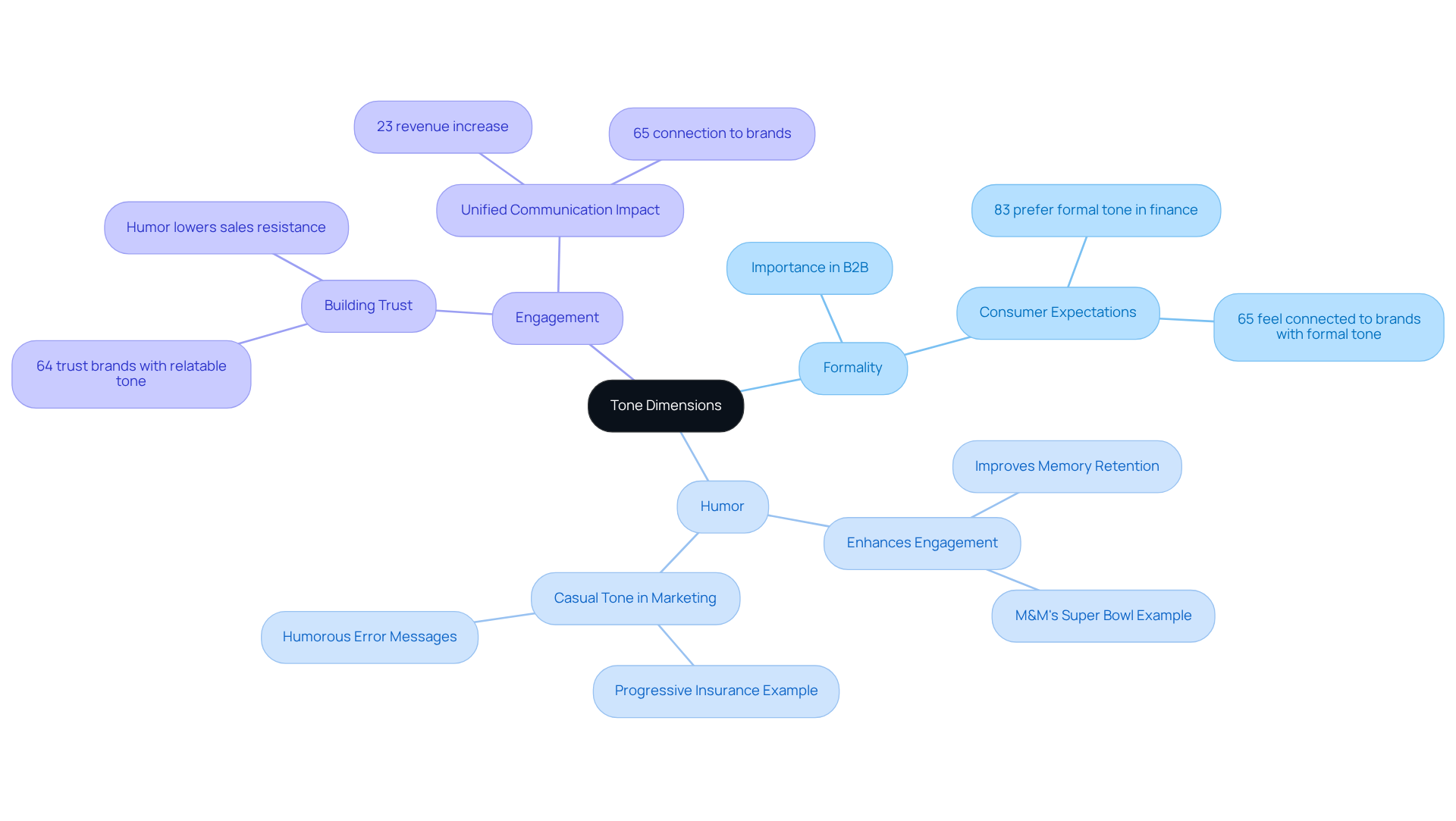
Learning from Leaders: Tone of Voice Examples from Successful Brands
Many brands struggle with the tone of voice definition in a crowded marketplace, and this challenge can feel overwhelming. Successful brands, however, exemplify effective strategies that align with the tone of voice definition and truly resonate with their audiences. Take Mailchimp, for instance. They embrace a friendly and welcoming style, fostering a personal connection that enhances engagement. This approach is not just a nice-to-have; it’s backed by the statistic that 85% of buyers believe colors and sound significantly influence purchasing choices. This highlights how Mailchimp's approach can deepen customer interactions and build loyalty.
In contrast, IBM adopts a more formal manner, reflecting its expertise and professionalism—qualities that align with the expectations of its corporate audience. This method is crucial, especially considering that 94% of initial impressions are linked to design, including style. IBM's formal tone effectively enhances its overall perception in the market.
As you examine these instances, consider how startups can draw inspiration from such strategies. Developing a unique style that resonates with your identity and meets the tone of voice definition while fulfilling audience expectations is essential. It’s heartening to note that companies with uniform messaging across channels can experience revenue increases of up to 23%. In fact, over two-thirds (68%) of firms indicate that consistency has contributed to revenue growths of 10% or more. This underscores the significance of having a clearly defined style, as the tone of voice definition not only connects with your audience but also drives your business forward.
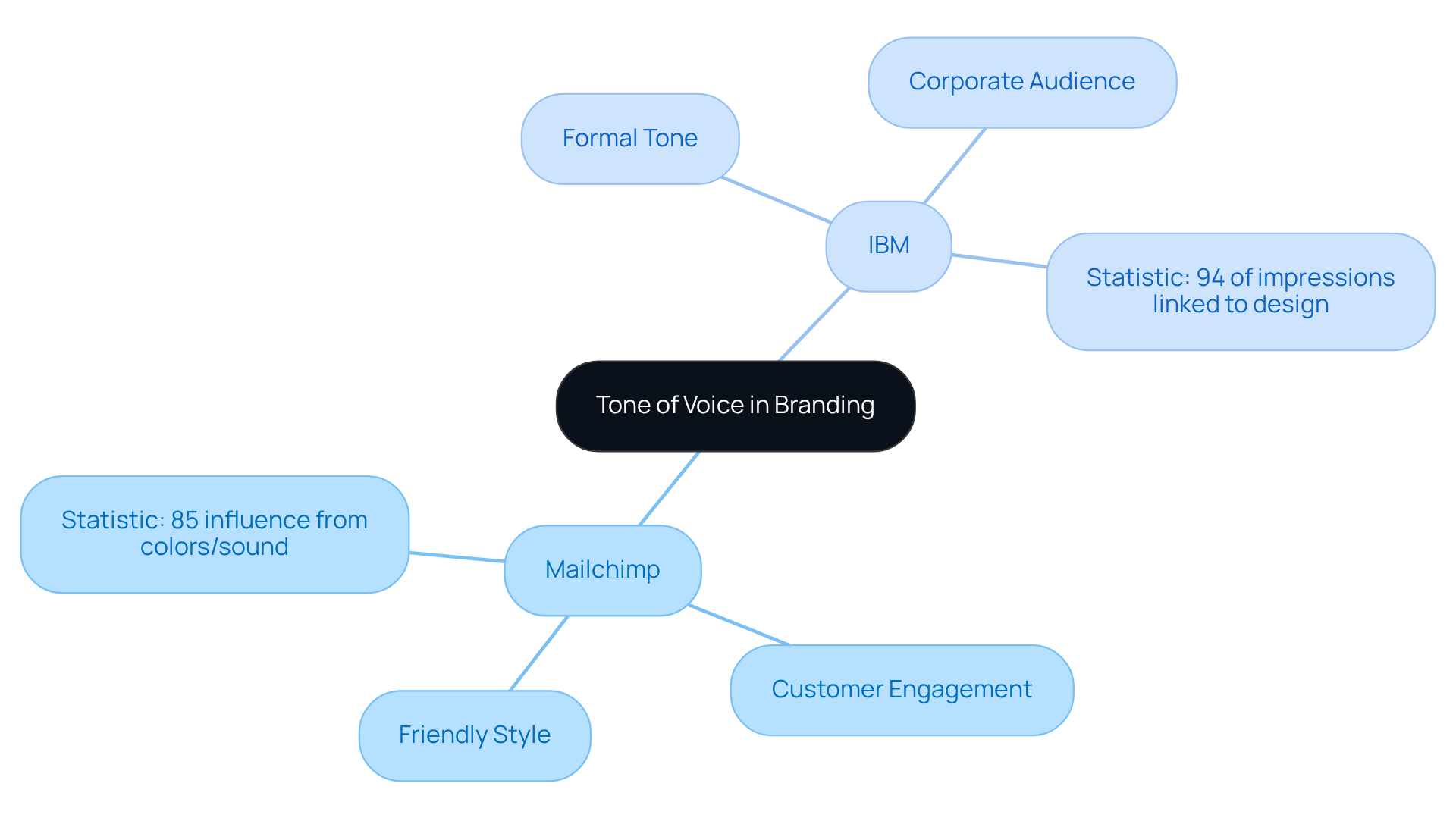
Distinguishing Tone of Voice from Brand Voice: Key Differences
While many often confuse intonation with company personality, it's essential to recognize that these are distinct concepts. The character of a company reflects its overall personality, while emotional inflection serves as the expression of that character in specific contexts. For startups, grasping this difference is vital for crafting a robust branding strategy. A consistent company persona can boost consumer confidence by 33%. Moreover, adapting this persona through various styles, tailored to different audiences and contexts, allows for flexibility while maintaining the core corporate identity.
However, it's crucial to understand that the tone of voice definition can significantly affect whether messages are perceived as insensitive, dull, or off-brand. This reality underscores the importance of thoughtful style adaptation. To navigate these challenges effectively, new ventures should consider creating a communication style guide that outlines their unique characteristics and variations. This guide can ensure consistency across all interactions, fostering a sense of trust and connection with their audience.
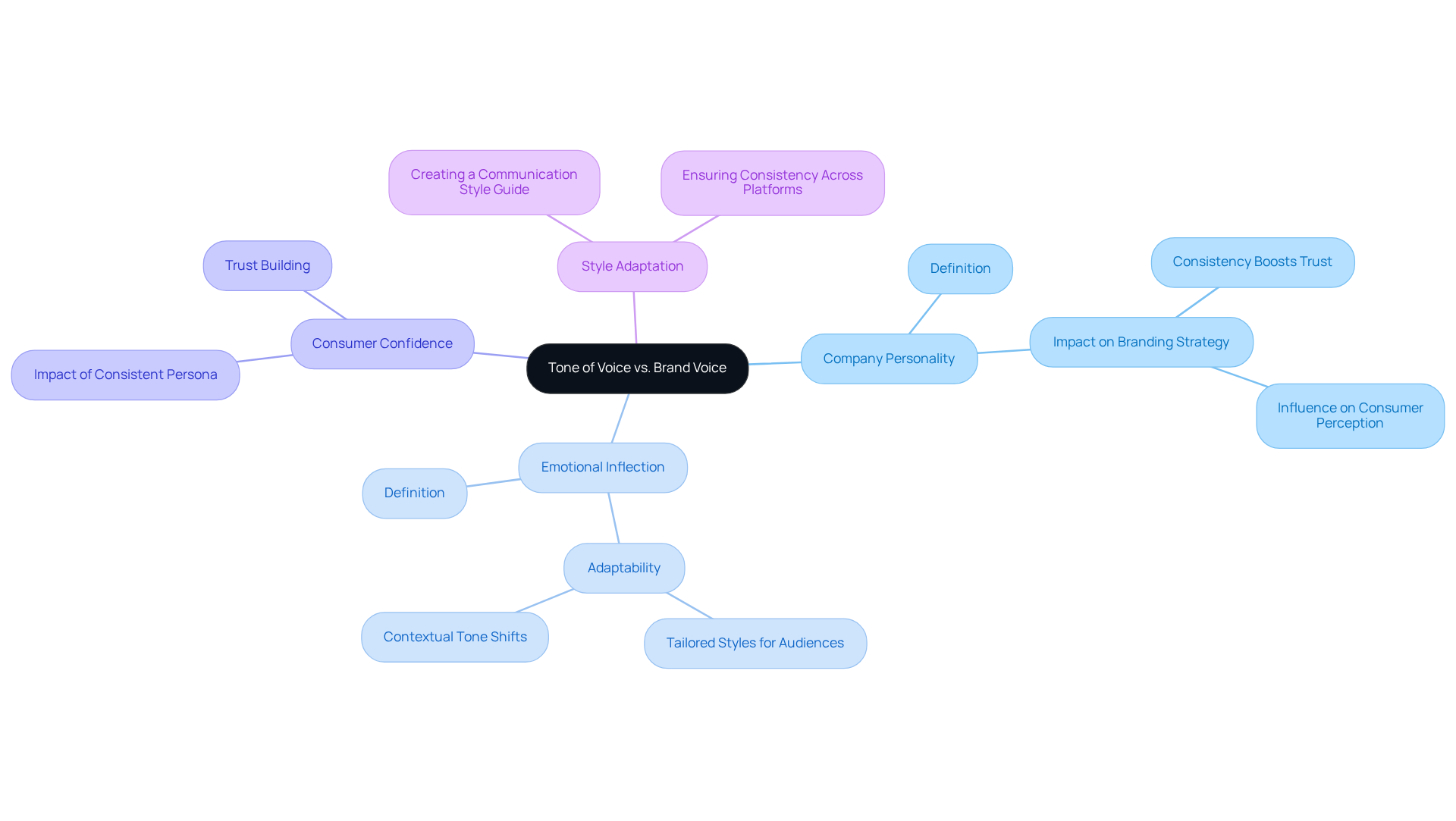
Adapting Tone of Voice: Ensuring Consistency Across Platforms
For startups, the challenge of preserving recognition is often daunting. It hinges on maintaining a steady style of communication across all platforms, including social media and email marketing. While adapting the style to fit various contexts is essential, the core elements must remain unchanged to strengthen your identity. This consistency not only aids in audience recognition but also fosters a deeper connection with your brand, regardless of the medium. To navigate this, new ventures should consider establishing comprehensive guidelines that empower all team members to understand and apply the tone uniformly.
Imagine the struggle of trying to connect with your audience when your message feels disjointed. Innovative strategies, like scaling omnichannel ambassador programs through influencer partnerships, can significantly enhance e-commerce engagement and community involvement. However, it’s worth noting that fewer than 10% of B2B companies report very consistent branding, which highlights the challenges many startups face.
A clearly articulated identity lays the groundwork for transparent and genuine communication, which is crucial for grasping the tone of voice definition. Upholding this uniformity can aid in revenue expansion, as 68% of businesses indicate that consistent identity contributes 10-20% to their revenue increase. Furthermore, aligning your company’s voice with consumer values is essential—68% of US adults prefer companies that reflect their personal values. Regular audits and updates of your style guide are vital to ensure ongoing relevance and effectiveness.
Consider implementing gamification strategies for influencer onboarding and developing sales funnel sequences to enhance your brand's presence. This can help ensure that your messaging resonates effectively with your target audience. A practical suggestion for new businesses is to frequently assess and improve your communication guidelines, allowing you to adapt to changing market trends and consumer preferences. Remember, you are not alone in this journey; many have faced similar challenges and found ways to thrive.
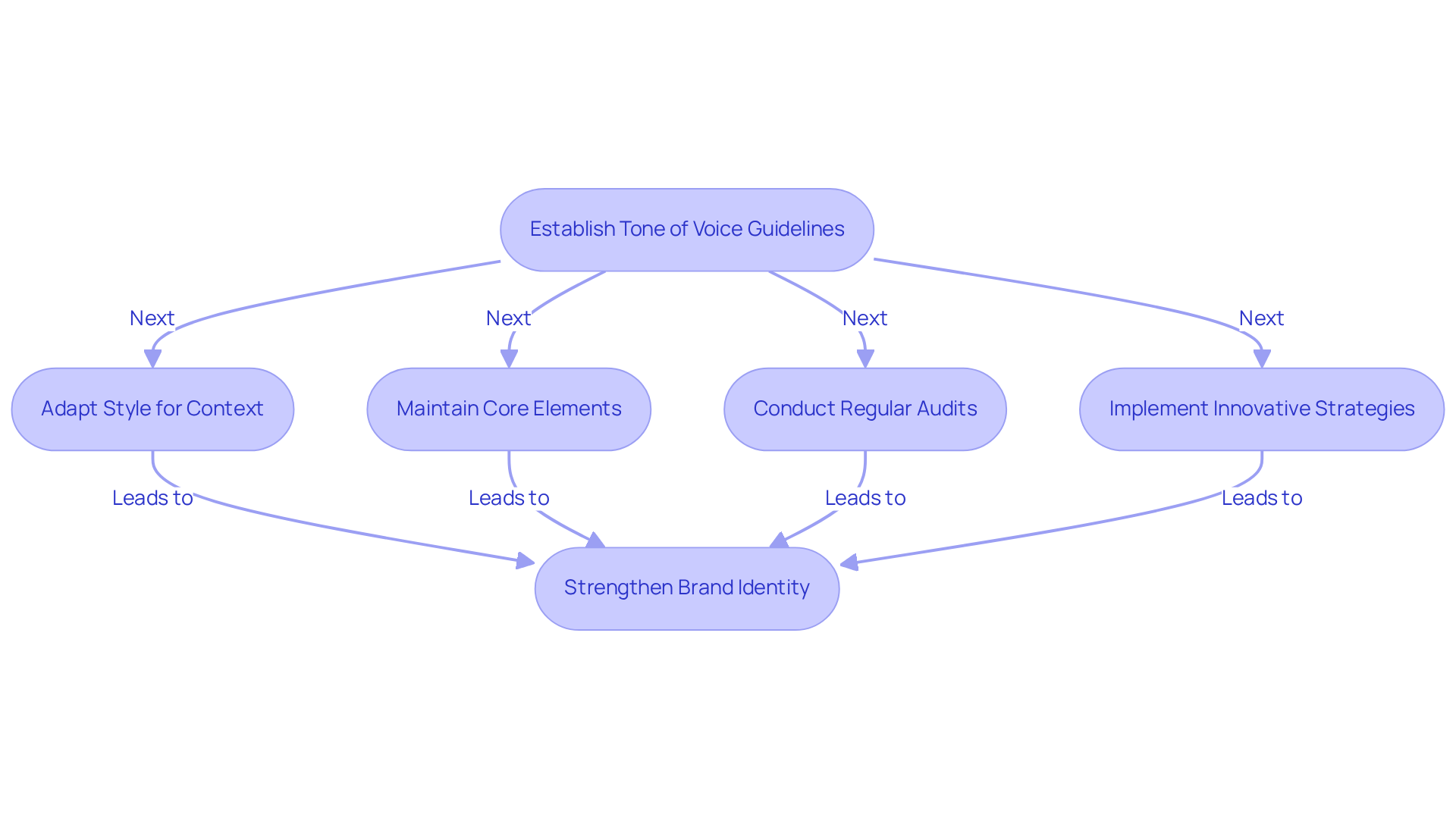
Creating a Tone of Voice Playbook: Guidelines for Consistent Messaging
Creating a voice playbook is essential for new businesses aiming to maintain uniform messaging across all platforms. Many founders struggle with ensuring that their communication reflects their brand identity, leading to confusion and missed opportunities. This can be particularly painful when potential customers encounter mixed messages, which can diminish their trust.
A well-structured playbook can alleviate these concerns by clearly outlining the company's voice, including key phrases, and providing examples of appropriate usage in various contexts. By establishing organized protocols, new ventures can ensure that every team member communicates in a way that resonates with the company's essence. This approach nurtures consistency, empowering teams to engage meaningfully with their audience.
In fact, a staggering 90% of potential customers expect a consistent experience across all marketing platforms, highlighting the importance of clear communication guidelines. Furthermore, companies that convey a steady message can enhance their revenue by 10-20%, illustrating the financial benefits of a well-articulated style.
Ultimately, the tone of voice definition within a comprehensive playbook serves as a vital resource for startups, helping them strengthen their brand messaging and foster deeper connections with their customers.
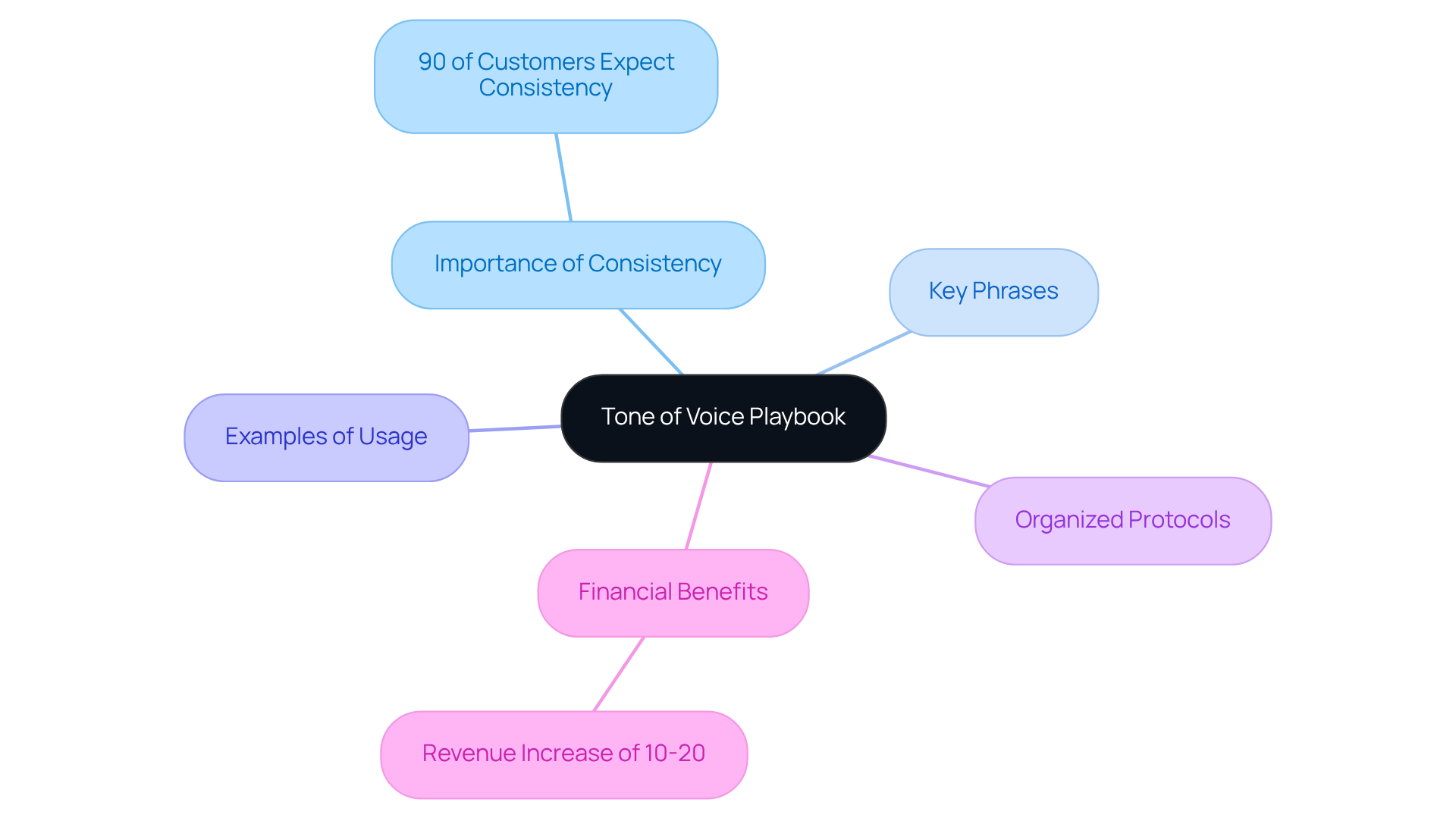
Conclusion
Establishing a clear tone of voice is not just an option for startups; it’s a vital part of building a compelling brand identity. Many founders struggle with how to communicate their values effectively, which can lead to disconnect with their audience in a crowded marketplace. By defining and consistently implementing a unique tone, new ventures can bridge this gap, fostering trust and loyalty—essential ingredients for long-term success.
Throughout this discussion, we’ve highlighted how a well-defined tone of voice can significantly enhance brand recognition and emotional engagement. It’s crucial to align communication styles with audience expectations, as emotional resonance can profoundly influence consumer behavior. Successful examples from brands like Slack and Mailchimp show us that thoughtful tone choices not only lead to growth but also cultivate customer satisfaction.
As we conclude, it’s important for startups to recognize the power of tone in shaping their brand narrative and nurturing consumer relationships. Creating a tone of voice playbook and ensuring consistency across all communication channels can help new businesses cultivate a strong identity that truly resonates with their target audience. Embracing these strategies doesn’t just enhance brand perception; it drives engagement and loyalty, ultimately paving the way for sustainable growth in an ever-evolving marketplace. Remember, you’re not alone on this journey—together, we can navigate the challenges and celebrate the successes.
Frequently Asked Questions
Why is establishing a unique tone of voice important for a brand?
A unique tone of voice is essential for nurturing a strong company identity, helping new ventures convey their values and character, stand apart from competitors, connect with target audiences, and foster lasting loyalty.
How does RNO1 help companies with their tone of voice?
RNO1 employs creative strategies, such as the Ryde initiative, to ensure communication aligns with the company's mission and vision, cultivating a cohesive identity that attracts and retains customers.
What impact does a well-defined tone of voice have on brand recognition?
A clearly defined tone of voice can significantly improve identity recognition and trust, making it an indispensable component of effective marketing strategies for new ventures.
What elements are included in the tone of voice definition?
The tone of voice encompasses word selection, style, and emotional influence, shaping every interaction from marketing content to customer service.
How does a consistent tone of voice affect customer loyalty?
Research shows that emotionally connected customers demonstrate higher brand loyalty, with 82% indicating that emotional connection influences their purchasing decisions.
What are the benefits of having a unique sound in brand communication?
A unique sound enhances brand recognition and loyalty, leading to increased revenue and customer satisfaction, as evidenced by successful companies like Slack.
What role does tone of voice play in building trust with consumers?
A well-crafted tone of voice shapes consumer perception, expresses trustworthiness and openness, and nurtures customer engagement and loyalty.
What percentage of consumers prefer companies that communicate with empathy and clarity?
82% of patients prefer organizations that demonstrate empathy and clarity in their communication.
How can startups maintain consistency in their tone of voice?
Recording a voice guide and tailoring the communication style for various platforms are vital steps to maintaining consistency and relevance.
What are the tangible benefits of a well-defined tone of voice?
Maintaining a consistent brand style can boost consumer trust by 33%, demonstrating the positive impact of a well-defined tone of voice on communication and brand perception.




